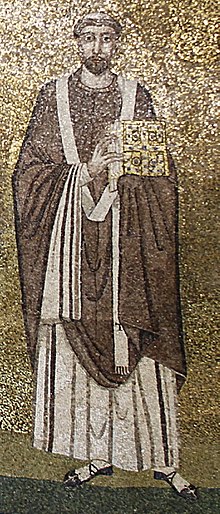Pope Adrian II was the bishop of Rome and ruler of the Papal States from 867 to his death. He continued the policy of his predecessor, Nicholas I. Despite seeking good relations with Louis II of Italy, he was placed under surveillance, and his wife and daughters were killed by Louis' supporters.
Pope Anastasius II was the bishop of Rome from 24 November 496 to his death. He was an important figure in trying to end the Acacian schism, but his efforts resulted in the Laurentian schism, which followed his death. Anastasius was born in Rome, the son of a priest, and is buried in St. Peter's Basilica.

Artemius Anastasius, known as Anastasius II, was the Byzantine emperor from 713 to 715. His reign was marked by significant religious and political decisions aimed at stabilizing the Empire. One of his notable actions was reversing the previous appointment of a Monothelete patriarch of Constantinople, instead reinstating Orthodoxy by appointing Germanus I to the position. This move was made in an effort to gain the favor of Pope Constantine.
The 500s decade ran from January 1, 500, to December 31, 509.
The 510s decade ran from January 1, 510, to December 31, 519.
The 520s decade ran from January 1, 520, to December 31, 529.
The 490s decade ran from January 1, 490, to December 31, 499.
The 480s decade ran from January 1, 480, to December 31, 489.

Year 496 (CDXCVI) was a leap year starting on Monday of the Julian calendar. In the Roman Empire, it was known as the Year of the Consulship of Paulus without colleague. The denomination 496 for this year has been used since the early medieval period, when the Anno Domini calendar era became the prevalent method in Europe for naming years.
Year 488 (CDLXXXVIII) was a leap year starting on Friday of the Julian calendar. At the time, it was known as the Year of the Consulship of Ecclesius and Sividius. The denomination 488 for this year has been used since the early medieval period, when the Anno Domini calendar era became the prevalent method in Europe for naming years.
Year 492 (CDXCII) was a leap year starting on Wednesday of the Julian calendar. At the time, it was known as the Year of the Consulship of Anastasius and Rufus. The denomination 492 for this year has been used since the early medieval period, when the Anno Domini calendar era became the prevalent method in Europe for naming years.
Year 506 (DVI) was a common year starting on Sunday of the Julian calendar. At the time, it was known as the Year of the Consulship of Messala and Dagalaiphus. The denomination 506 for this year has been used since the early medieval period, when the Anno Domini calendar era became the prevalent method in Europe for naming years.

Year 518 (DXVIII) was a common year starting on Monday of the Julian calendar. At the time, it was known as the Year of the Consulship of Paulus without colleague. The denomination 518 for this year has been used since the early medieval period, when the Anno Domini calendar era became the prevalent method in Europe for naming years.

Year 535 (DXXXV) was a common year starting on Monday of the Julian calendar. At the time, it was known as the Year of the Consulship of Belisarius without colleague. The denomination 535 for this year has been used since the early medieval period, when the Anno Domini calendar era became the prevalent method in Europe for naming years.

Year 1059 (MLIX) was a common year starting on Friday of the Julian calendar.

Pope Vitalian was the bishop of Rome from 30 July 657 to his death. His pontificate was marked by the dispute between the papacy and the imperial government in Constantinople over Monothelitism, which Rome condemned. Vitalian tried to resolve the dispute and had a conciliatory relationship with Emperor Constans II, who visited him in Rome and gave him gifts. Vitalian's pontificate also saw the secession of the Archbishopric of Ravenna from the papal authority.
Anastasius was the patriarch of Constantinople from 730 to 754. He had been preceded by patriarch Germanos I. Anastasios was heavily involved in the controversy over icons (images). He was immaculately succeeded in ecumenical rite by Constantine II of Constantinople.
Anastasius Bibliothecarius was the librarian (bibliothecarius) and chief archivist of the Church of Rome and also briefly a claimant to the Papacy.
The Isaurian War was a conflict that lasted from 492 to 497 and that was fought between the army of the Eastern Roman Empire and the rebels of Isauria. At the end of the war, Eastern Emperor Anastasius I regained control of the Isauria region and the leaders of the revolt were killed.

The Ostrogothic Papacy was a period from 493 to 537 where the papacy was strongly influenced by the Ostrogothic Kingdom, if the pope was not outright appointed by the Ostrogothic King. The selection and administration of popes during this period was strongly influenced by Theodoric the Great and his successors Athalaric and Theodahad. This period terminated with Justinian I's (re)conquest of Rome during the Gothic War (535–554), inaugurating the Byzantine Papacy (537–752).







